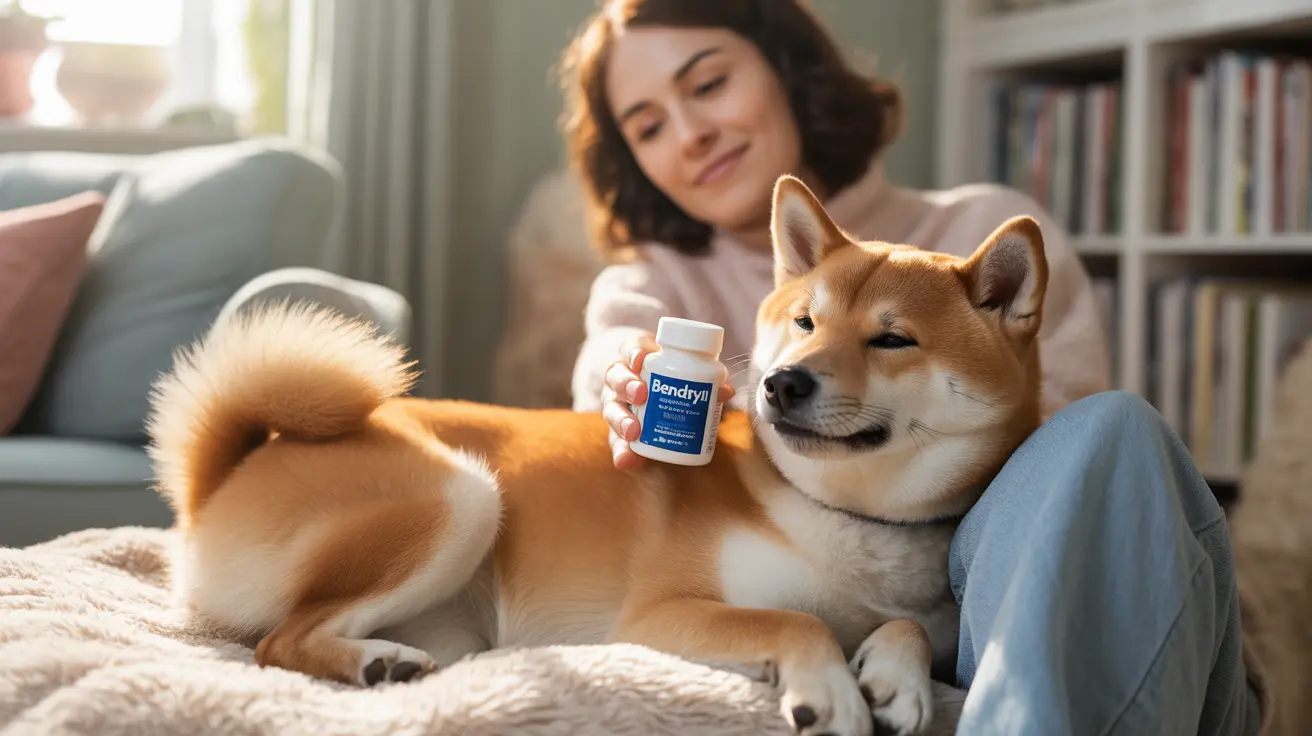When it comes to managing allergies and mild reactions in our canine companions, Benadryl (diphenhydramine) has become a widely recognized option among pet owners. This over-the-counter medication, while primarily known for human use, has gained acceptance in veterinary medicine for treating various conditions in dogs, from allergic reactions to motion sickness.
Before considering Benadryl for your dog, it's crucial to understand that what works safely for humans may not always be appropriate for our four-legged friends. This comprehensive guide will explore the proper use of Benadryl in dogs, including safety considerations, correct dosing, and when to seek alternative treatments.
While Benadryl can be beneficial in certain situations, it's essential to remember that veterinary consultation should always precede any medication administration, even for over-the-counter products like Benadryl.
Understanding How Benadryl Works in Dogs
Benadryl functions as a first-generation antihistamine, working primarily by blocking H-1 histamine receptors throughout your dog's body. This mechanism helps control allergic reactions by preventing histamine from triggering common symptoms like itching, swelling, and inflammation.
Additionally, diphenhydramine affects the brain's chemoreceptor trigger zone and vestibular system, making it effective for treating motion sickness in dogs. This dual action explains its versatility in veterinary applications and its popularity as a go-to remedy for mild health incidents requiring prompt relief.
Common Uses for Benadryl in Dogs
Allergy Management and Itch Relief
Benadryl effectively manages mild to moderate allergic reactions in dogs. It is commonly used to address symptoms caused by several allergy sources, such as environmental allergens, insect bites or stings, seasonal triggers, and mild skin reactions. Its ability to alleviate itching and reduce swelling offers comfort for dogs experiencing these mild to moderate allergic responses. However, it is not designed to treat severe allergic reactions, which require immediate veterinary care.
- Environmental allergens (pollen, dust, mold)
- Insect bites or stings
- Seasonal allergies
- Mild skin reactions
Motion Sickness Treatment
For dogs that struggle with nausea related to travel, Benadryl serves as an effective treatment for motion sickness. Its effects on the vestibular system help regulate balance and decrease the likelihood of vomiting or nausea during car rides or other types of travel. This can help make journeys less stressful for both pets and their owners.
Proper Benadryl Dosage for Dogs
The correct dosage of Benadryl for dogs is essential for both efficacy and safety. The general guideline is to administer 1 mg per pound of body weight, given every 8 to 12 hours (or 2-3 times daily). However, you should never exceed the recommended dose or extend the duration of administration without consulting your veterinarian first. Accurate weighing of your dog and using plain diphenhydramine tablets—not combination products—is critical.
- 1 mg per pound of body weight
- Administered 2-3 times daily (every 8-12 hours)
- Never exceed the recommended dosage without veterinary approval
Always consult your veterinarian to adjust the dose for puppies, older dogs, or those with health complications.
Safety Considerations and Contraindications
While Benadryl is generally considered safe for canine use, some dogs may have conditions that preclude its administration. These include dogs with pre-existing heart or respiratory issues, liver disease, or glaucoma. Special care should also be taken in pregnant or lactating females and those receiving other medications, as drug interactions may occur. If your dog has any chronic illness or is already on medication, always discuss Benadryl's suitability with your veterinarian.
- Heart or respiratory conditions
- Liver disease
- Glaucoma
- Pregnancy
- Pre-existing medical conditions
- Concurrent medications
Certain situations, such as advanced age or specific breed sensitivities, may also influence whether Benadryl is appropriate for your pet. Always err on the side of caution and follow expert guidance.
Recognizing Side Effects
Most dogs tolerate Benadryl well, but some may experience side effects. The most common reactions include drowsiness, dry mouth, mild gastrointestinal upset (such as vomiting or diarrhea), urinary retention, and, less frequently, paradoxical excitement—especially in young or sensitive dogs. Monitoring your dog after administration is important; if unexpected symptoms develop, discontinue use and contact your veterinarian immediately.
- Drowsiness
- Dry mouth
- Urinary retention
- Mild gastrointestinal upset
- Potential paradoxical excitement
Be alert for any unusual behavioral changes, which may suggest intolerance or overdose.
Alternative Options for Dog Allergy Relief
If Benadryl is unsuitable or ineffective, other medications and therapies may be recommended by your veterinarian. Alternatives such as cetirizine (Zyrtec) and loratadine (Claritin) are sometimes used in dogs, though their safety and proper dose must be determined by a professional. Prescription medications, medicated shampoos, and immunotherapy are other options for dogs with chronic or severe allergic conditions. Each alternative has its own indications, safety profile, and efficacy, so professional advice is key in selecting the best option for your dog's specific needs.
- Cetirizine for dogs (Zyrtec)
- Claritin for dogs (loratadine)
- Prescription medications
- Medicated shampoos
- Immunotherapy options
Implementing environmental controls, such as frequent cleaning and minimizing exposure to known allergens, can also play an important role in reducing allergy symptoms in dogs.
When to Seek Veterinary Care
Certain symptoms require immediate veterinary intervention. If your dog displays signs of a severe allergic reaction—such as facial swelling, difficulty breathing, sudden collapse, or a rapid increase in heart rate—go straight to the nearest veterinary clinic. Other warning signs include excessive sedation, persistent vomiting or diarrhea, unusual behavior changes, or suspected Benadryl overdose. Prompt medical attention can be life-saving in these situations.
- Severe allergic reactions
- Difficulty breathing
- Excessive sedation
- Unusual behavior changes
- Signs of Benadryl overdose
Even after minor side effects, consult your veterinarian to determine if continuation of Benadryl is safe.
Frequently Asked Questions
- What is Benadryl used for in dogs? Benadryl is used to treat allergies, itching, mild allergic reactions, anxiety, and motion sickness in dogs.
- Is Benadryl safe for dogs? Benadryl is generally safe for most dogs when given in the correct dose, but always consult your vet first.
- What is the proper Benadryl dosage for dogs? The typical dose is 2-4 mg per kg of body weight, every 8 to 12 hours; always confirm with your veterinarian.
- Can Benadryl be used for chronic itching in dogs? Benadryl is not usually effective for chronic itching or severe allergies; better suited for mild, occasional reactions.
- What are common side effects of Benadryl in dogs? Drowsiness and mild sedation are most common; rarely, upset stomach or allergic reaction may occur.
- Are there alternatives to Benadryl for dogs' allergies? Alternatives include cetirizine and loratadine, but consult your vet before use.
- Can Benadryl be used for dog motion sickness? Yes, Benadryl can help with motion sickness due to its effects on the nervous system.
- What should I avoid when giving Benadryl to my dog? Avoid products containing other ingredients like decongestants or alcohol; use only plain diphenhydramine.
- How quickly does Benadryl work in dogs? Benadryl typically starts to take effect within 30 minutes and lasts for 8-12 hours.
- What should I do if my dog has a bad reaction or overdoses on Benadryl? Contact your veterinarian immediately for emergency instructions if you suspect an overdose or severe reaction.
Conclusion
Benadryl can be a valuable tool in managing various conditions in dogs, but its use should always be approached with caution and under veterinary guidance. Remember, every dog is unique—what works for one may not work for another. Accurate dosing and vigilant monitoring are key to ensuring your dog's safety. When in doubt, always prioritize professional veterinary advice. Your diligence helps keep your furry companion healthy, comfortable, and safe.






